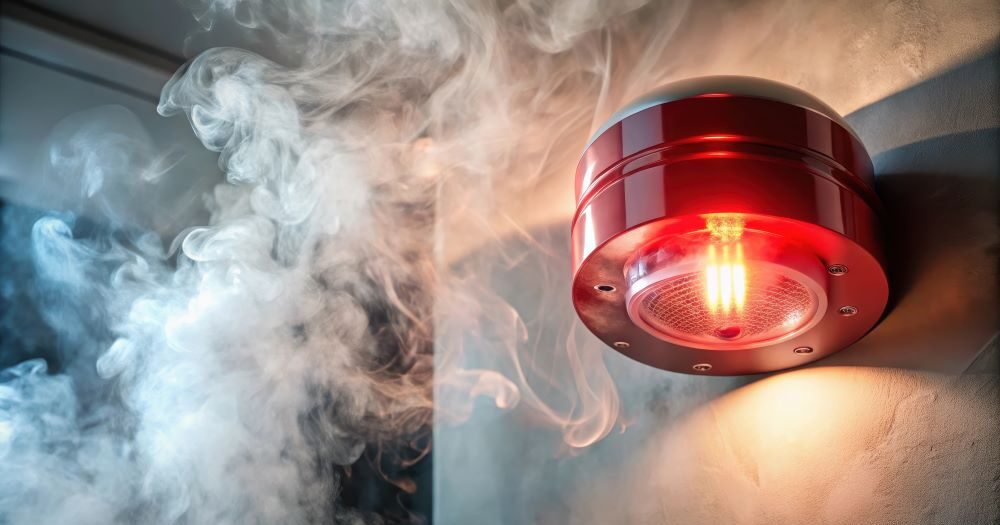In today’s world, where everything is more connected and threats are becoming more complex, having reliable visual and audible alert devices is more important than ever. These tools are essential parts of modern fire and intrusion security systems.
While the core technologies like smoke detectors, motion sensors and door or window contacts do the job of detecting issues, it’s the alerting devices that really make the difference. They take those quiet signals and turn them into actions that can save lives.
Related Article: Leveraging Digital Signage Infrastructure for Campus Emergency Mass Notifications
Relying on just one way to communicate during an emergency isn’t enough anymore. To meet today’s safety standards and the needs of consumers, it’s important to use both loud, multi-tone sirens that can be heard over background noise and bright strobe lights that grab attention.
These sirens are designed to be powerful enough to be noticed without being so loud that they damage hearing. When combined with high-intensity lights, they make sure that everyone, including people who are hard of hearing or wearing headphones, gets the message. This combination not only helps people respond more quickly and safely, but it also aligns with important safety codes like NFPA 72 and ADA guidelines.
Visual and Audible Alerts: More Than Just Redundancy
Using both sound and light isn’t just about having a backup. Each type of alert serves a unique purpose. Audible alarms like horns, sirens or voice evacuation systems are great for cutting through noise and delivering urgent messages.
Visual alerts, including flashing lights or LEDs, make sure that people see the warning even if they can’t hear it. This is especially important in places like factories, schools, or hospitals, where noise levels can be high or people might be distracted. In homes, visual alerts are crucial for people who may be hearing-impaired or ones who may be using noise-canceling devices.
Related Article: 12 School Emergency Strategies that Protect Students with Disabilities
More and more, security installers are designing systems that include both types of alerts as a standard feature. It’s not just a nice-to-have anymore; it’s a must for full coverage and to meet safety regulations, especially in areas that follow NFPA or ADA standards.
Integration with Smart Security Platforms
An impactful evolution in the industry is how these alert devices are now integrated into larger smart security systems. They’re no longer just standalone gadgets. Today’s devices are connected, programmable and work together with other systems including fire alarms, mass notification tools, access control and video surveillance.
For instance, if a smoke detector goes off, it can trigger a strobe light, sound an alarm, send a notification to your phone, unlock exit doors, and alert emergency services—all at once. This kind of automation makes emergency responses faster and more accurate. It also reduces the chances of human error, which can be critical in high-risk places like nursing homes or schools.
Innovation in Form and Function
Manufacturers are also stepping up their game by creating alert devices that are not only effective but also look good and are easy to use. New sounders can play different tones at different volumes depending on the type of emergency—whether it’s a fire, break-in, or carbon monoxide leak.
Related Article: Making Safety Plans Actionable with Mass Notification
Strobe lights can now use different colors to indicate different types of threats, which is especially helpful in places where people speak different languages or where multiple uses are happening at once.
Guidance for Visual and Audible Alert Deployment
Schools, universities and hospital should consider the following when in the market for alert devices:
- The environment:Different settings like factories, homes, or hospitals have different needs when it comes to noise, lighting and how many people are around.
- Volume and brightness:Loud alarms and bright lights are great for big or noisy areas, but adjustable settings might be better for smaller or mixed-use spaces.
- Where to install:Devices should be placed where they’ll be most effective, along escape routes and near high-risk areas like kitchens or entryways.
- Smart features:Devices that can be checked and controlled remotely save time and help keep the system running smoothly.
- Code compliance:Always follow the manufacturer’s instructions and make sure the system meets local and national safety standards.
For campuses with tight budgets, it’s smart to focus on the most important areas first. Even a phased rollout of alert devices can make a big difference, especially if the current system is outdated or limited.
Evolving Expectations and Opportunities
Looking ahead, the line between detection, alerting and automation will continue to blur. As machine learning becomes more common in security systems, alerts might adjust automatically based on the time of day, how many people are around, or past activity.
With AI-powered video verification, alerts could soon be tied to confirmed events, reducing false alarms and making real ones more accurate.
Campus security professionals should see these changes not as optional upgrades, but as the new standard. In a world where threats are more advanced and people expect more from their technology, offering smart, integrated and multi-sensory alert systems isn’t just a good idea; it’s essential.
Rick Sheets is vice president of monitoring and compliance at Brinks Home. This article originally ran in CS sister publication Security Sales & Integration and has been edited.
Note: The views expressed by guest bloggers and contributors are those of the authors and do not necessarily represent the views of, and should not be attributed to, Campus Safety.







